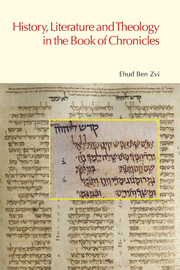Book contents
- Frontmatter
- Dedication
- Contents
- Acknowledgments
- Abbreviations
- Part I INTRODUCTORY ESSAYS
- Part II CHRONICLES AND THE REREADING AND WRITING OF A DIDACTIC, SOCIALIZING HISTORY
- Part III CHRONICLES AND THEOLOGY AS COMMUNICATED AND RECREATED THROUGH THE REREADING OF A HISTORIOGRAPHICAL, LITERARY WRITING
- Chapter 8 A SENSE OF PROPORTION: AN ASPECT OF THE THEOLOGY OF THE CHRONICLER
- Chapter 9 OBSERVATIONS ON WOMEN IN THE GENEALOGIES OF 1 CHRONICLES 1–9
- Chapter 10 IDEOLOGICAL CONSTRUCTIONS OF NON-YEHUDITE/PERIPHERAL ISRAEL IN ACHAEMENID YEHUD: THE CASE OF THE BOOK OF CHRONICLES
- Chapter 11 A GATEWAY TO THE CHRONICLER'S TEACHING: THE ACCOUNT OF THE REIGN OF AHAZ IN 2 CHRONICLES 28.1–27
- Chapter 12 THE AUTHORITY OF 1–2 CHRONICLES IN THE LATE SECOND TEMPLE PERIOD
- Part IV CHRONICLES AND LITERATURE: LITERARY CHARACTERIZATIONS THAT CONVEY THEOLOGICAL WORLDVIEWS AND SHAPE STORIES ABOUT THE PAST
- Bibliography
- Index of Biblical Works Cited
- Index of Authors and Individuals Cited
Chapter 12 - THE AUTHORITY OF 1–2 CHRONICLES IN THE LATE SECOND TEMPLE PERIOD
from Part III - CHRONICLES AND THEOLOGY AS COMMUNICATED AND RECREATED THROUGH THE REREADING OF A HISTORIOGRAPHICAL, LITERARY WRITING
- Frontmatter
- Dedication
- Contents
- Acknowledgments
- Abbreviations
- Part I INTRODUCTORY ESSAYS
- Part II CHRONICLES AND THE REREADING AND WRITING OF A DIDACTIC, SOCIALIZING HISTORY
- Part III CHRONICLES AND THEOLOGY AS COMMUNICATED AND RECREATED THROUGH THE REREADING OF A HISTORIOGRAPHICAL, LITERARY WRITING
- Chapter 8 A SENSE OF PROPORTION: AN ASPECT OF THE THEOLOGY OF THE CHRONICLER
- Chapter 9 OBSERVATIONS ON WOMEN IN THE GENEALOGIES OF 1 CHRONICLES 1–9
- Chapter 10 IDEOLOGICAL CONSTRUCTIONS OF NON-YEHUDITE/PERIPHERAL ISRAEL IN ACHAEMENID YEHUD: THE CASE OF THE BOOK OF CHRONICLES
- Chapter 11 A GATEWAY TO THE CHRONICLER'S TEACHING: THE ACCOUNT OF THE REIGN OF AHAZ IN 2 CHRONICLES 28.1–27
- Chapter 12 THE AUTHORITY OF 1–2 CHRONICLES IN THE LATE SECOND TEMPLE PERIOD
- Part IV CHRONICLES AND LITERATURE: LITERARY CHARACTERIZATIONS THAT CONVEY THEOLOGICAL WORLDVIEWS AND SHAPE STORIES ABOUT THE PAST
- Bibliography
- Index of Biblical Works Cited
- Index of Authors and Individuals Cited
Summary
1. Introduction
1–2 Chronicles provides an alternative account of Israelite/Judean history that basically parallels the account in 1 Samuel–2 Kings (deuteronomistic history), yet it differs from deuteronomistic history not only about specific details but also in its theological and historiographical approach. Thus, from the fourth century BCE (the probable date of Chronicles), two different and often conflicting accounts of the monarchic period were available. What did this situation mean?
In many societies, the image of a distant historical past functions as a means of self-understanding. This image (‘remembrances’ + the inferred historical ‘laws’) provides a conceptual framework for the understanding of contemporary reality, making this reality meaningful to the individual as well as to society as a whole. Since the historical image as pattern transforms unique situations into illustrations of an ongoing historical process, the ‘laws’ governing this historical process and past patterns of response turn out to be applicable to the present situation. The ‘knowledge’ thus gained is dependent not only on specific historical images but also on the conceptual world of the interpreter. Consequently, a wide range of lessons may be derived from similar historical images.
Israel often turned to its image of the past in order to understand present situations (see, for instance, the interpreted summaries of the Israelite past in Ezekiel 20; Psalm 106; Nehemiah 9; Sirach 44–50; Jdt. 5.5–21; CD 3; Wis. 10; 1 Macc. 2.51–61; 3 Macc. 6.2–8; 4 Macc. 18.9–19; Acts 7.2-–53; Hebrews 11).
- Type
- Chapter
- Information
- History, Literature and Theology in the Book of Chronicles , pp. 243 - 268Publisher: Acumen PublishingPrint publication year: 2006



